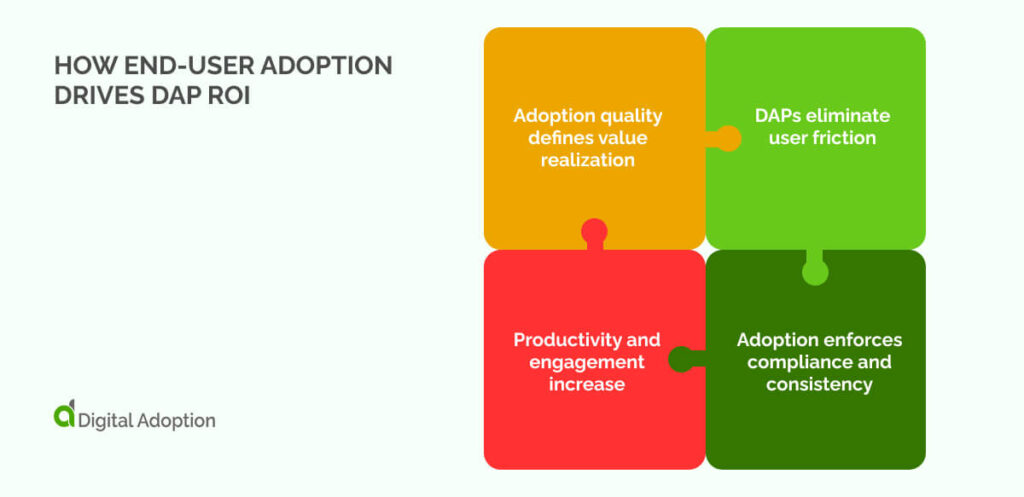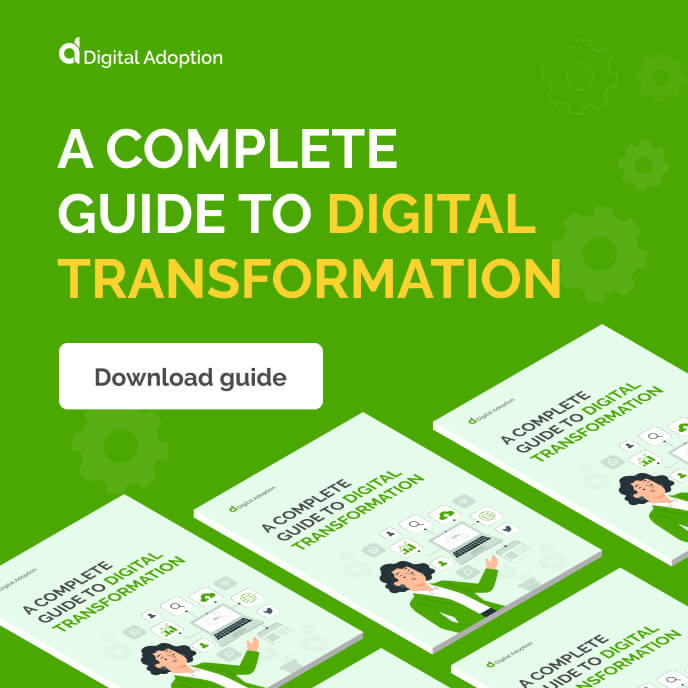Across industries, organizations are accelerating digital transformation, investing heavily in new tools and enterprise software. Yet many struggle to realize the full value of those investments because employees fail to adopt and use technology as intended.
When adoption stalls, performance gains vanish, and so does ROI. Without clear visibility into how users interact with systems, leaders can’t link technology spending to business impact. This lack of insight leaves transformation efforts fragmented and costly.
Digital adoption platforms (DAPs) bridge that gap. Beyond onboarding and in-app guidance, they deliver analytics that reveal how technology is actually used and where friction occurs.
As the global DAP market is projected to surpass $12.5 billion by 2034, measuring return on these platforms is becoming essential. Understanding DAP ROI ensures that people, processes, and technology evolve together — turning digital transformation from a challenge into a measurable advantage.
- Why measure DAP return on investment (ROI)?
- What does the DAP data say?
- How end-user adoption drives DAP ROI
- What are the different DAP pricing models?
- Methods and KPIs to measure digital adoption platform (DAP) ROI
- What other DAP cost factors need to be considered?
- What are the benefits of a digital adoption platform on ROI?
- What are the challenges of a digital adoption platform on ROI?
- Are DAPs worth it?
- People Also Ask
Why measure DAP return on investment (ROI)?
Measuring the return on investment (ROI) of a digital adoption platform isn’t about understanding the concept — it’s about proving the impact. Business leaders want assurance that digital tools drive enough value to justify their cost.
But DAP ROI goes beyond simple financial metrics. It includes how effectively employees adopt software, where workflows break down, and how those patterns influence productivity and engagement. These outcomes are harder to quantify yet vital to understanding the platform’s full value.
A strong DAP ROI signals that technology is being embraced, support costs are decreasing, and cultural transformation is taking hold. A weak ROI, on the other hand, uncovers friction — whether from usability issues, poor process design, or low adoption rates.
Ultimately, measuring DAP value provides more than numbers; it reveals the state of enterprise digital adoption and distinguishes between merely using tools and truly integrating them.
What does the DAP data say?
Recent research highlights just how costly poor digital adoption can be.
Gartner reports that digital worker productivity has declined by 9–12% over the past two years due to workflow complexity and tool friction — meaning employees lose nearly one-tenth of their productive time navigating digital systems.
A well-implemented digital adoption platform (DAP) directly addresses that friction. By guiding users in real time and analyzing engagement patterns, it helps organizations recover lost productivity and maximize software ROI.
The IMARC Group estimates the DAP market at $761 million in 2024, with forecasts predicting exponential growth over the next decade. This surge reflects enterprise recognition that digital enablement tools drive measurable performance gains.
As the market expands, so does the expectation for clear ROI metrics — proof that DAPs are not just adoption tools, but data-driven engines of digital value realization.
How end-user adoption drives DAP ROI

End-user adoption is the single most important factor determining the return on investment (ROI) of a digital adoption platform (DAP).
When employees fully embrace new tools, organizations realize faster value, stronger performance, and greater cultural alignment around technology.
Adoption quality defines value realization
DAPs register metrics such as engagement rates, task completion speed, and in-app interaction data, revealing whether adoption is translating into intended outcomes. Measuring how users engage with new systems through quantifiable DAP data delivers a trusted method for determining ROI.
Productivity and engagement increase
Users’ ability to navigate complex UI mitigates confusion and quickens the time required to realize a solution’s value. Employees follow through self-paced workflows steadily and incrementally, building engagement and understanding.
Data shows that ROI can be impacted by unchecked skills gaps, which can raise labour costs by 20 – 40% per role each year. Targeted internal upskilling via DAPs preserves talent value and reinforces overall return on DAP investments.
DAPs eliminate user friction
Users who fully utilize DAPs
By embedding contextual guidance — such as tooltips, walkthroughs, and automated tutorials — DAPs reduce digital friction and accelerate learning curves. Each avoided error and support request directly contributes to lower operational costs and improved software utilization.
Adoption enforces compliance and consistency
Standardized workflows help employees follow processes correctly, cutting compliance-related costs by up to 25%, according to industry research. Consistent process adherence mitigates risk, enhances stakeholder confidence, and strengthens the business case for DAP investment.
Ultimately, end-user adoption transforms DAPs from passive tools into measurable engines of digital ROI.
What are the different DAP pricing models?

The various pricing models for DAPs offer different ways for organizations to invest in digital adoption. Understanding these options helps businesses choose an approach that will work in the long term without having to overspend or compromise:
| Model | Summary | ROI Focus |
| Subscription | Recurring fee; includes updates/support. | Predictable costs, scales with adoption. |
| Perpetual | One-time license; lifetime access. | Lower long-term spend if usage stays high. |
| Usage-Based | Pay per active user/session. | Spend tracks real adoption value. |
| Tiered | Features/users increase by plan. | Scalable ROI tied to growth stages. |
| Hybrid | Base subscription + add-ons. | Balances flexibility and cost control. |
- Subscription model: Offers continuous platform access for a recurring fee. Ideal for organizations seeking predictable spend, automatic updates, and ongoing vendor support. Scales seamlessly as adoption grows and more users are onboarded.
- Perpetual license: A single upfront payment grants lifetime access. Best suited for stable user bases that prefer capital expenditure over recurring costs. Encourages teams to focus on sustained utilization and ROI over time.
- Usage-based pricing: Charges vary according to active users, sessions, or workflows. Fits organizations with fluctuating demand or seasonal workforce changes, directly linking spend to actual adoption.
- Tiered pricing: Packages features and user counts into progressive tiers. Enables smaller teams to start cost-effectively while larger enterprises unlock advanced functionality as adoption deepens.
- Hybrid model: Combines a base subscription with usage-based or premium add-ons. Balances predictability with flexibility, supporting diverse teams and varied adoption needs.
Choosing the right model ensures your DAP investment scales efficiently and delivers measurable value.
Methods and KPIs to measure digital adoption platform (DAP) ROI
If you’ve ever wondered whether your DAP is actually paying off, this section is for you. The two tables below break down both the methods and KPIs you need to see what’s working, what isn’t, and how every action users take translates into measurable ROI:
Methods
The table below shows key methods to track DAP adoption, what each measures, and simple ways to monitor progress in everyday terms:
| Method | What it measures | How to track |
| Vendor-provided analytics dashboards | Where users click, pause, or skip steps in the DAP | Check the dashboard to see what users do and where they get stuck |
| Structured user surveys and feedback | How users feel and what challenges they face | Ask users quick questions or provide feedback forms after using the software |
| A/B testing of training approaches | Which guidance methods help users learn the fastest | Try two ways of training and see which one people follow better |
| Integration with performance management tools | How DAP usage affects employee performance | Link DAP activity to employee results to see the impact |
| Tracking time-to-competency for new hires | How quickly new hires become productive | Record how long it takes new employees to get up to speed |
KPIs
The table below outlines KPIs that reveal your DAP impact, what it measures, and simple ways to calculate each so that you can measure ROI:
| KPI | What it measures | Formula |
| User adoption gains | How many users actively use the software versus those who have access | (Number of active users ÷ total users) × 100 |
| Productivity improvements | Time saved after DAP implementation compared to before. | Output after DAP – output before DAP |
| Reduced support ticket volume | Fewer helpdesk requests are tied to better user guidance. | Previous tickets – current tickets |
| Accelerated time-to-proficiency | How quickly employees reach full productivity. | Average training time before DAP – average training time after DAP |
| Enhanced data quality and process compliance | Fewer input errors and better completion of required steps. | (Accurate entries ÷ total entries) × 100 |
| Employee satisfaction scores | Employee sentiment toward software usability and guidance. | (Sum of survey ratings ÷ total responses) × 100 |
| Faster adoption of change | How quickly users adapt to new features or workflows. | (Users successfully adopting change ÷ total users) × 100 |
| Higher proficiency in enterprise software capabilities | Depth of user skill in completing complex workflows. | (Proficient users ÷ total users) × 100 |
What other DAP cost factors need to be considered?
Proactive businesses have contingency plans and forecasting techniques that account for the additional costs associated with a DAP. This is called the total cost of ownership (TCO), which considers both direct and indirect financial costs associated with commissioning an asset across its entire lifecycle.
Here is a simple table overview of the outgoing costs resulting from DAP purchase, usage, and licensing:
| Cost factor | How to manage |
| Software subscription and licensing fees | Track contract terms, plan for renewals, and ensure the license aligns with actual user numbers. |
| Deployment and implementation challenges | Map out resources, timelines, and responsibilities to avoid delays or hidden expenses. |
| Content development and customization costs | Budget for creating guides, alerts, and workflows, and reuse assets where possible. |
| Administrative and management overhead | Assign clear ownership, monitor usage, and streamline processes to minimize staff effort. |
| Ongoing maintenance and support expenses | Schedule regular updates, track issues, and plan support to prevent surprises and maintain adoption. |
What are the benefits of a digital adoption platform on ROI?
The benefits of a DAP on ROI can be understood by examining data that reveals patterns, informs decisions, and highlights opportunities to optimize adoption.
These are the benefits of a digital adoption platform on ROI:
- Faster user onboarding: Employees often spend unnecessary time figuring out how new tools work. A DAP that shortens the time from first login to full confidence turns onboarding into forward momentum instead of delay. That speed then contributes directly to software ROI because value starts showing up sooner.
- Higher user engagement: Organizations that follow digital adoption best practices report up to a 30% increase in application utilization. When a DAP boosts engagement, you’re ensuring it’s used effectively, which lifts ROI.
- Accelerated feature adoption: The average core‑feature adoption rate across sectors is only 24.5%. DAPs that guide users into advanced functionality unlock latent value in software investments, turning low utilization into higher-capability gains and stronger ROI.
What are the challenges of a digital adoption platform on ROI?
The challenges of a DAP on ROI emerge when adoption barriers, user behavior, and system limitations create friction that slows value realization.
These are the key challenges that can hinder a digital adoption platform from delivering its full ROI:
- Under‑utilization: Employees disengage when tools are confusing or unused features keep piling up. When a DAP sits idle or is only used sparingly, the investment stalls. Software ROI never moves forward because the platform doesn’t change how people work. It is just “there” in the background, not influencing real output.
- Change fatigue: Constant change wears people down, and patience tends to drop fast. When the workplace already feels unstable, even a strong DAP rollout loses momentum because users shut down emotionally before they ever adopt the new workflows.
- Inadequate integration: 73% of CX software users struggle with data integration across systems. If a DAP cannot connect to legacy tools or workflows, it fails to embed user behaviour, and the software’s ROI remains inaccessible.
Are DAPs worth it?
DAPs are among the most significant investments a company makes in its processes, technology, and people.
Effectively managing ROI is essential for measuring the sustainability of adoption efforts. The last thing any business wants is wasted digital technology investments or having to switch vendors midway through a contract.
Understanding all the ways a DAP delivers ROI is the only way to see the results. For CIOs and other digital leaders, using the digital adoption metrics, data, calculations, and insights in this article can be used to gauge DAP ROI in more concrete ways.
The burning question remains. Are DAPs worth it? The short answer is yes. However, a DAP only delivers lasting value when adoption is measured, understood, and optimized. Remember to track digital transformation KPIs consistently, revisit your methods regularly, and link every insight to real business results.
People Also Ask
-
What is a digital adoption platform (DAP)?A digital adoption platform (DAP) is a user onboarding and training solution that teaches end-users how to maximize enterprise software and digital applications. DAPs are typically overlaid on top of enterprise software, helping users navigate its user interface (UI). They directly support user adoption strategies, ensure compliance, and fast-track employee productivity towards ideal business outcomes.
-
What potential risks should be considered when implementing a DAP?Risks include employees not using the platform, it not connecting properly with your other software, or staff feeling overwhelmed by changes. If these aren’t managed, the DAP won’t deliver value. Planning training, support, and tracking usage early helps avoid these problems.
-
Are digital adoption platforms suitable only for large enterprises?Not at all. Small and medium businesses can benefit too. Any company with multiple tools or complicated workflows can use a DAP to help staff learn faster, use software correctly, and get more value from their technology.
-
Can a DAP support both customer-facing and internal applications?Yes. A DAP can guide both employees and customers through software. It helps people use the tools correctly, reduces mistakes, and ensures your investment in software pays off across the board.









